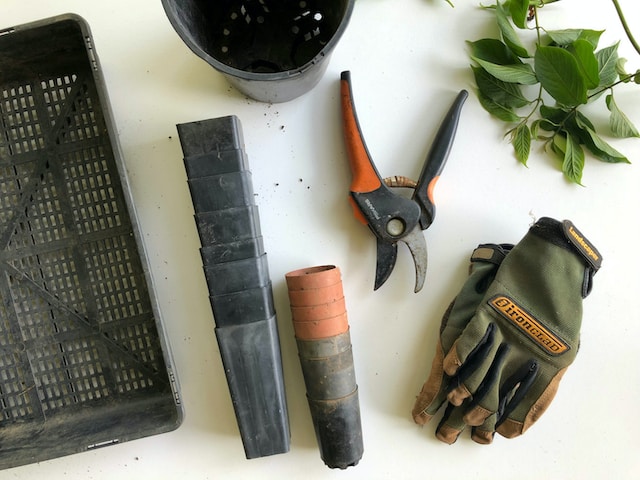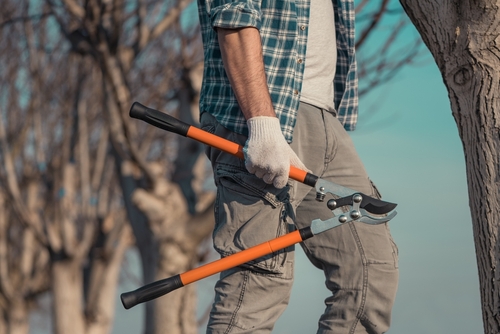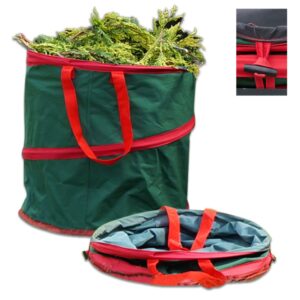Log in or create new account to save this product to your wishlist.
How to Choose the Right Pruning Tools
Pruning is a relatively straighforward task, but the whole job is easier with the right tools. Find out which tools to use for each pruning task.
Latest articles
7 MIN 22 Jul How to keep your lawn in shape this summer 9 MIN 15 Jul Watering Your Garden: 10 Top Tips! 11 MIN 15 Jul Is Your Grass Type Right for your Garden? 11 MIN 10 Sep Create Your Low-Maintenance Garden – Tips and Ideas 11 MIN 08 Sep The Ultimate Guide to Choosing the Perfect Hedges for Your Garden 12 MIN 30 Aug The Top 20 Evergreen Climbers to Transform Your GardenIs your garden becoming overgrown and unwieldy? Are you struggling to keep on top of fast-growing plants? And while pruning is a simple task, it’s more difficult without the correct pruning tools.
- Why good pruning tools are essential
- The different types of cutting tools for the garden
- Staying sharp: maintenance tips for a longer lifespan
- FAQs
Pruning shears are an essential tool for garden lovers and professionals alike. However, choosing the right pruning tool is vital to ensure you achieve excellent results that protect the longevity of your plants and shrubs.
This article explores the correct pruning tools for each job — examining their characteristics, benefits, and applications.
Ready? Let’s get started!
Why good pruning tools are essential
Pruning is typically straightforward, but you need the right tools to prune efficiently and effectively. And each pruning tool has its advantages, so choosing the right tool for each job is essential.
However, the fundamental rule of pruning is this:
Always use clean, sharp blades for all garden tasks. Never prune with blunt, dirty tools — you could damage your plants, causing disease and susceptibility to pests.
So, when choosing your pruning tools, consider:
- The ergonomics — how it feels in your hand and how easy it is to manipulate the blades
- The blade size — use smaller cutters for small plants; it’s difficult to be precise with overly large blades
- The blade material — cheap cutters may rust or go blunt quickly. Always opt for high-quality cutting tools that are easy to clean and keep sharp
- The maintenance — can you replace the blades or the handles? Or are you opting for a lower-grade model that will require more regular replacement?
- Safety — choose a pruning tool with a blade lock and a non-slip grip
The different types of cutting tools for the garden

There are four main types of pruning tools:
- Home-garden-and-kitchen pruners — small handheld cutters, closer to scissors than secateurs; a useful all-purpose tool for pruning thin, small branches, herbs, and shrubs.
- Branch loppers — pruning shears with short blades and long handles designed to help you reach higher branches of shrubs and trees. The long handles make it easier to cut through thicker branches.
- Pruning saws — a course-toothed blade for working through thicker branches on shrubs and trees.
- Hedge trimmers — designed expressly for pruning and cutting hedges and shrubs into shape.
As a general guideline, choose:
- Regular pruning shears for branches up to 2.5cm thick
- Branch loppers for branches between 2.5cm and 5cm.
- Pruning saws or electric hedge trimmers for branches wider than 5cm.
The two main types of secateurs are bypass and anvil shears. Generally speaking, bypass sheers are great for close, precision work, while anvil cutters offer better leverage for cutting larger branches.
Bypass secateurs

This is the most commonly used secateur type, perfect for pruning live branches and making precise, clean cuts.
Bypass secateurs have two sharp blades that make them especially suitable for pruning flower bushes, such as roses, and young, supple branches on shrubs and small trees.
Anvil secateurs

These are heavy-duty cutters with a single blade that presses against a blunt plane (the anvil), making them the natural choice for pruning dead branches and woody, thicker stems.
It may seem counterintuitive, but the single-blade action of anvil cutters offers a more powerful cut than double-bladed bypass secateurs.
These cutters typically come with longer arms, offering greater leverage to cut through stubborn, dead wood. However, anvil cutters can damage live plants due to the squeezing action of the cut.
Ratchet secateurs

The main benefit of ratchet secateurs lies in the ratchet springs that allow you to cut through resistant stems in stages.
The ratchet system works with either bypass or anvil blades by repeatedly squeezing and releasing the handles to work through stubborn branches incrementally.
Ratchet secateurs are particularly helpful to those with a weak grip or lack of arm strength.

- Shrinks down for easy storage
- Expands to large capacity
- Collect your pruning clippings for easy disposal
Battery-powered or electric secateurs
A convenient time- and effort-saving tool, the electric secateur offers powerful cutting performance with relatively little physical effort.
I recommend electric secateurs for anyone with limited arm or hand strength or if you’re pruning a substantially large garden.
Battery-powered models offer the power of electric cutting without the cables and are supplied with built-in or replaceable rechargeable batteries.
Garden doctor Louis says:
If you’re considering buying a battery-powered cutter, go for a model with more than one rechargeable battery. That way, you can just swap batteries rather than wait for the entire unit to recharge.
Telescopic secateurs
These cutters come with extra long handles, making them ideal for pruning higher branches and shrubs without a ladder.
They offer additional range and are generally safer to use than garden ladders.
You can extend telescopic secateurs by as much as 4m!
Garden doctor Louis says:
Secateurs should fit into your hand. There are models designed for left-handers or extra-large models for people with big hands.
Staying sharp: maintenance tips for a longer lifespan
Once you’ve found the perfect pruning tools, you should consider how to maintain them. Regular maintenance keeps the mechanism in good working order and protects your plants from diseases.
Here are my top maintenance tips for your pruning tools:
- Keep them clean — Use a nylon pan scourer or wire wool pad with soapy water to remove dirt and sap from the blades. Get into the habit of doing this after each use.
- Lubricate the moving parts — Regularly apply lubricant to the spring and hinge to ensure a clean cutting action. Replace the spring if it’s showing signs of rust.
- Sharpen your blades — sharp blades give you a safer cut. Use a knife sharpener regularly to keep the cutting edge precise.
- Store your secateurs in a dry place to prevent rust.
FAQs
It depends on the work you intend to do with your secateurs. If you’re going to prune small bushes and thin stems, a handheld bypass secateur will be fine. If cutting thick branches, use an anvil secateur with longer or telescopic arms.
This type of secateur is ideal for pruning tough, woody stems and dead branches. These secateurs have one cutting blade and one blunt edge, which allows you to cut with less physical force and are perfect for heavy-duty pruning.
These are the most common types of pruning tools — sometimes also known as Parrot Beak secateurs. They consist of two sharp cutting blades that provide a clean cut, ideal for pruning live branches and suited for precision pruning.
Anvil secateurs are ideal for pruning tough, woody stems and dead branches. Anvil secateurs have one cutting blade and one blunt edge, which allows you to cut with less physical force. Anvil secateurs are perfect for heavy-duty pruning.
Any questions?
I hope you have all the information to help you choose which pruning tools to buy. But if you have any questions, add a comment at the end of this article or drop us an email. Either way, we’ll get back to you as soon as possible.
Or check out our comprehensive Help & Advice section — for all your expert lawn care and gardening tips!
Thanks for reading!
Leave a comment
Your answer will be displayed on the site and the interested party will be notified by email.
Leave a comment
Have a question or want to share your experience? Leave us a comment.
Read more
The best tips and tricks for a lush green lawn
 7 MIN
13 Sep
Lavender Cuttings: a step-by-step guide
7 MIN
13 Sep
Lavender Cuttings: a step-by-step guide
 11 MIN
10 Sep
Create Your Low-Maintenance Garden – Tips and Ideas
11 MIN
10 Sep
Create Your Low-Maintenance Garden – Tips and Ideas
 Scarifying Kit
All products after scarifying | Quickly restores the lawn after scarifying | Outsmart weeds quickly with the use of this kit
From: € 39.99
Scarifying Kit
All products after scarifying | Quickly restores the lawn after scarifying | Outsmart weeds quickly with the use of this kit
From: € 39.99
 Spring Lawn Care Kit
MOOWY’s choice for the spring | Quick recovery of your lawn after winter | A strong lawn prevents weeds
From: € 25.99
Spring Lawn Care Kit
MOOWY’s choice for the spring | Quick recovery of your lawn after winter | A strong lawn prevents weeds
From: € 25.99
 Long Lasting Lawn Fertiliser
Effective for 90 days | See results in 14 days! | Suitable for all types of grass and soil
From: € 13.99
Long Lasting Lawn Fertiliser
Effective for 90 days | See results in 14 days! | Suitable for all types of grass and soil
From: € 13.99
Do you want a lawn calendar?
🌱 All important maintenance moments for your lawn during the year. Leave your email and we will send you the lawn calendar for free.
Enter your email
Receive the lawn calendar in the mail
Enjoy a green lawn all year round!










Comments (0)
There are no comments yet. Well then, what are you waiting for to
Be the first to write your comment!inaugurate this pretty page?
Do you have some comments?